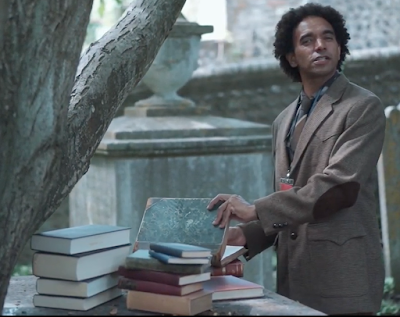ON FAIRY TALES Joseph Coelho
I've been working in schools for over 20 years, long before I was published, finding ways for children to engage with writing. I soon realised that the best way to get them interested is to listen to them and their passions. On several occasions I found that primary aged children would want to talk or write about zombies and werewolves and vampires and I realised that there wasn't a great deal available for them that was appropriate to their age and their wonderful minds so I got writing.
I decided to go with fairy tales because writing plays for children had taught me that if you want to get bums on seats in the theatre then it helps to have a known quantity, so if you can't adapt a well know IP what can you do? You can, of course, adapt a fairy tale, and it helped that fairy tales have their own history of being far darker than the more sanitised versions we have inherited.
The narrator is a librarian who discovers some rotting books going ‘bad’. You used to work with rare volumes in the British Library, how much of that experience fed into these tales?
I have had the pleasure of working in several libraries. When you're busy shelving books as a library assistant there is a lot of time to think and daydream. I think for this reason libraries often turn up as settings in my books from Luna Loves Library Day to The Girl Who Became A Tree to The Fairy Tales Gone Bad series, libraries have always managed to worm their way into my make believe.
Fairy tales never seem to go out of fashion. Why do you think that is?
They key into something archetypal. They embody stories and relationships and symbols that we recognise, we all want to be the king or the queen or the princess, we recognise the symbolism of vanity in Snow White's witch, or the danger of abandoning the path in Little Red Riding Hood. They are stories from times when humanity lived smaller lives closer to the ground, at one with the forests. There are warnings and messages in the tales that we instinctively know are for our benefit.
If you could be a fairy-tale character for a day what would it be and why?
I would be Anansi, trickster and god, holder of all the stories. It would be amazing to have Anansi's wit and cleverness even for just a day.
Ha, no. One thing I know from working with kids is that they are hungry for stories that push at the edges of being scary and delight and surprise.
You wrote, produced and performed Zombierella as a play initially. What were the challenges and highlights of adapting the story for a book?
I had performed Zombierella well over a hundred times before I adapted it into the book version. Adapting the story to book form was fairly seamless. But I did get the chance to add bits and flesh sections out which was great. As a play it was all narrative and dialogue but as a book I had description to play with and the complete pleasure of working with the brilliant illustrator Freya Hartas.
Are there any books from your childhood that led you to this trio of weird and wonderful mash-ups? And what were your favourite books as a child?
I have very distinct memories of learning to read with the Ladybird fairy-tale series. The watercolour illustrations were scarily realistic. I remember the witch in Snow White leering over her poisoned apple and the troll under the bridge in Three Billy Goats Gruff. No doubt these books left an impression. My favourite books included Raymond Briggs' Fungus The Bogey Man and anything by Roald Dahl.
For me it's all about having fun with language, playing with words, finding phrases that ski off the tongue. I strongly believe that characters and story should come first and that good structure and verse are like a solid foundation that I hope will non-invasively give pleasure to the reader. Have them giggling without always knowing why.
Has the symbolism in fairy tales found its way into your other work?
I think for many writers there are symbols and themes that repeat across their work. For me, I would say it’s the power of stories and imagination that pops up especially strongly in Frankenstiltskin but also in some of my other work like The Hairdo That Got Away and The Girl Who Became A Tree. In Creeping Beauty family is a fairly strong theme which also pops up In Overheard In A Tower Block and The Boy Lost In The Maze. In many ways, writing is a way of exploring those subjects and themes that are important to me.
*Header image: Joseph Coelho on YouTube, reading from Frankenstiltskin, illustrated by Freya Hartas
(Screenshot by Françoise Price)
*
Françoise Price is deputy editor of Words & Pictures weekly online magazine. Contact: deputyeditor@britishscbwi.org. Find her on Twitter: @FranGPrice

















No comments:
We love comments and really appreciate the time it takes to leave one.
Interesting and pithy reactions to a post are brilliant but we also LOVE it when people just say they've read and enjoyed.
We've made it easy to comment by losing the 'are you human?' test, which means we get a lot of spam. Fortunately, Blogger recognises these, so most, if not all, anonymous comments are deleted without reading.